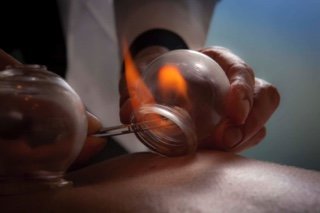Cupping increases blood flow and helps detox – but what does that mean? When a muscle is contracted, the muscle fibers temporarily compress capillaries. Hypertonicity, what you might call a “tight” muscle, is when the muscle is stuck in contraction. The chronic pressure on the capillaries results in ischemia (lack on blood). Without fresh, circulating blood, there is limited oxygen and the muscles start to depend on the anaerobic production of ATP*, also leaving a build-up of lactic acid. When you haven’t worked out for a while and start up again, there is generally a stronger soreness at the beginning as the lactic acid gets released. Aside from a lack of ATP, the lack of blood flow also creates electrolyte imbalances which further impede proper contraction and relaxation of the muscle. You’ve probably heard the potassium in bananas can help a muscle spasm, although I find 400-500 mg of magnesium works best. Calcium can also start to build up in the tissue. Cupping increases blood flow by stimulating mast cells in the skin and activating the axon reflex. Mast cells are part of the immune system, they are most present in our skin, lungs, and GI tract (these tissues are most vulnerable as they are exposed to your external environment and need a quick defense). Histamine (vasodilator), Heparin (blood thinner), growth factors (stimulates growth\repair), prostaglandins (hormonal like lipid compounds), leukotrienes (mediate inflammation) are also released via the mast cells. The combination helps with not only new cell growth, but also help remove cellular waste by attracting phagocytes. The axon reflex, or “flare” because of the redness, also causes vasodilation. The increased blood also increases the warmth of the muscle which can improve flexibility. The often immediate pain relief is due to the fact that touch sensory nerves use fast conducting myelinated fibers whereas pain sensation is conducted on slow, non-myelinated fibers. The stimulus from cupping can potentially block the pain signal. This is how those menthol and camphor creams (Icy/Hot creams) help temporarily mask pain. You can have instant improved range of motion, less pain, and initiate tissue repair. But what about the marks? The petechia or bruising typically only appear where there is muscle\fascia adhesions (“knots”), ischemia, and\or scar tissue from repetitive motion or trauma. On average, the marks go away 4-7 days. If you keep cupping the area after the marks fade, each time the marks are generally less as the injured tissue underneath has been repaired. Because of its influence on the mast cells, cupping can also be used during a cold to help kick start the immune system. There are quite a few more conditions in which cupping can help and research is still being done to understand what else it does. Having practiced cupping with acupuncture for 14 years, I don’t need a ‘study’ to tell me it works, nor does Michael Phelps I imagine. *(Revisiting Biology 101, ATP is energy produced through aerobic metabolism (Krebs cycle) with use of oxygen. When oxygen is not available, a much smaller amount of energy can be produced though anaerobic glycolysis however lactic acid is the byproduct.


